Financial Management Report: Decisions, Government Role, and Planning
VerifiedAdded on 2019/12/28
|7
|1882
|199
Report
AI Summary
This report provides a comprehensive overview of financial management, emphasizing its importance in the competitive business landscape. It defines the objectives of financial management, highlighting its role in ensuring fund availability, minimizing costs, and making investment decisions. The report delves into three crucial financial decisions: investment, financing, and dividend decisions, explaining their significance in maximizing shareholder wealth. It also examines the role of the government in assisting businesses through financial support, reduced taxation, and training programs. Furthermore, the report explores the interaction between business planning and decision-making, emphasizing their correlation in achieving organizational goals. The report concludes by reinforcing the significance of financial planning and management for successful business operations and growth.

Financial management
1
1
Paraphrase This Document
Need a fresh take? Get an instant paraphrase of this document with our AI Paraphraser

Table of Contents
INTRODUCTION................................................................................................................................3
1. Clear evaluation of the objective/purpose of financial management and three main decisions. .3
2. Role of government in providing assistance to a business..........................................................4
3. Appraising the different interaction within business planning & decision-making.....................5
CONCLUSION....................................................................................................................................5
REFERENCES.....................................................................................................................................6
2
INTRODUCTION................................................................................................................................3
1. Clear evaluation of the objective/purpose of financial management and three main decisions. .3
2. Role of government in providing assistance to a business..........................................................4
3. Appraising the different interaction within business planning & decision-making.....................5
CONCLUSION....................................................................................................................................5
REFERENCES.....................................................................................................................................6
2
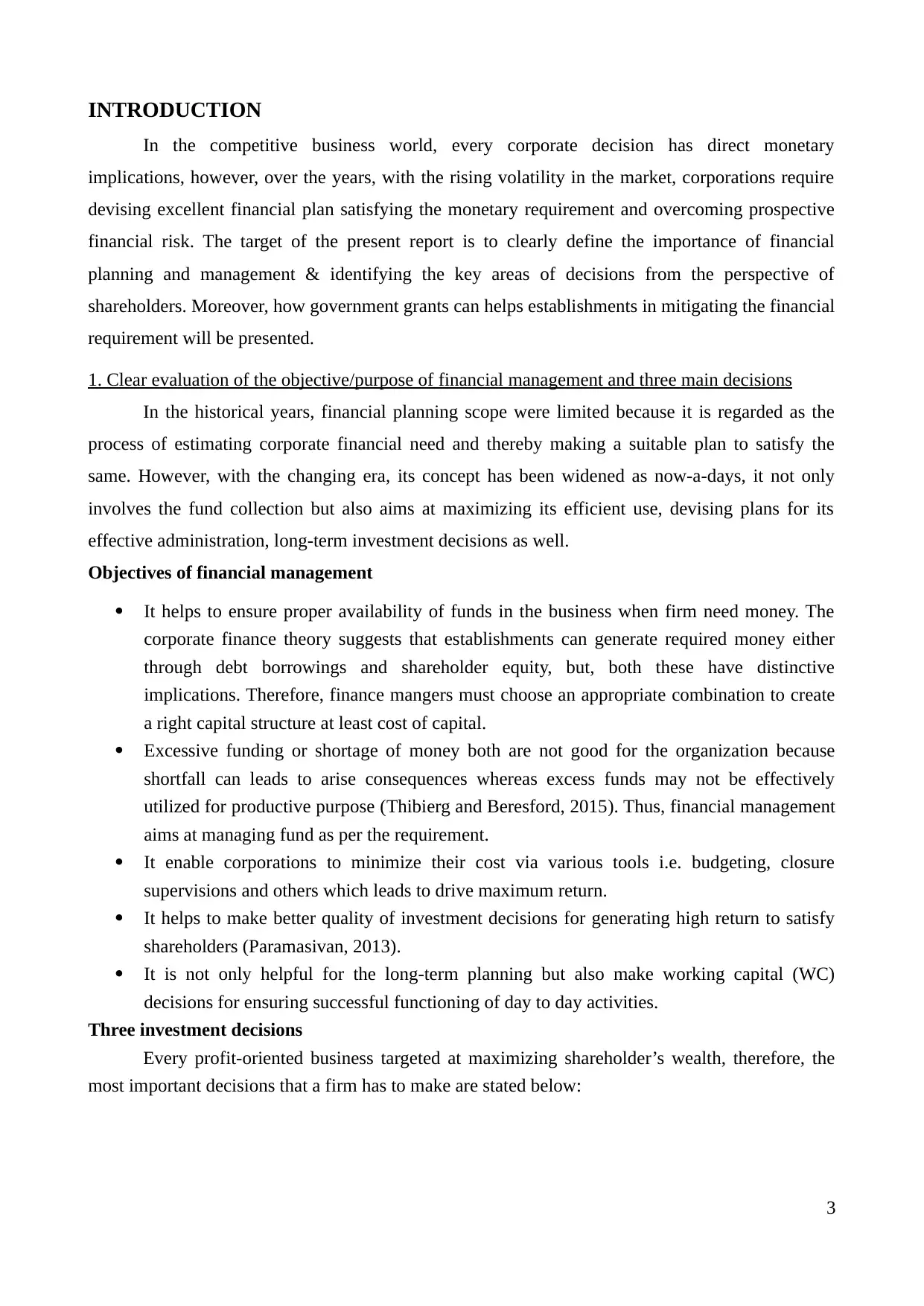
INTRODUCTION
In the competitive business world, every corporate decision has direct monetary
implications, however, over the years, with the rising volatility in the market, corporations require
devising excellent financial plan satisfying the monetary requirement and overcoming prospective
financial risk. The target of the present report is to clearly define the importance of financial
planning and management & identifying the key areas of decisions from the perspective of
shareholders. Moreover, how government grants can helps establishments in mitigating the financial
requirement will be presented.
1. Clear evaluation of the objective/purpose of financial management and three main decisions
In the historical years, financial planning scope were limited because it is regarded as the
process of estimating corporate financial need and thereby making a suitable plan to satisfy the
same. However, with the changing era, its concept has been widened as now-a-days, it not only
involves the fund collection but also aims at maximizing its efficient use, devising plans for its
effective administration, long-term investment decisions as well.
Objectives of financial management
It helps to ensure proper availability of funds in the business when firm need money. The
corporate finance theory suggests that establishments can generate required money either
through debt borrowings and shareholder equity, but, both these have distinctive
implications. Therefore, finance mangers must choose an appropriate combination to create
a right capital structure at least cost of capital.
Excessive funding or shortage of money both are not good for the organization because
shortfall can leads to arise consequences whereas excess funds may not be effectively
utilized for productive purpose (Thibierg and Beresford, 2015). Thus, financial management
aims at managing fund as per the requirement.
It enable corporations to minimize their cost via various tools i.e. budgeting, closure
supervisions and others which leads to drive maximum return.
It helps to make better quality of investment decisions for generating high return to satisfy
shareholders (Paramasivan, 2013).
It is not only helpful for the long-term planning but also make working capital (WC)
decisions for ensuring successful functioning of day to day activities.
Three investment decisions
Every profit-oriented business targeted at maximizing shareholder’s wealth, therefore, the
most important decisions that a firm has to make are stated below:
3
In the competitive business world, every corporate decision has direct monetary
implications, however, over the years, with the rising volatility in the market, corporations require
devising excellent financial plan satisfying the monetary requirement and overcoming prospective
financial risk. The target of the present report is to clearly define the importance of financial
planning and management & identifying the key areas of decisions from the perspective of
shareholders. Moreover, how government grants can helps establishments in mitigating the financial
requirement will be presented.
1. Clear evaluation of the objective/purpose of financial management and three main decisions
In the historical years, financial planning scope were limited because it is regarded as the
process of estimating corporate financial need and thereby making a suitable plan to satisfy the
same. However, with the changing era, its concept has been widened as now-a-days, it not only
involves the fund collection but also aims at maximizing its efficient use, devising plans for its
effective administration, long-term investment decisions as well.
Objectives of financial management
It helps to ensure proper availability of funds in the business when firm need money. The
corporate finance theory suggests that establishments can generate required money either
through debt borrowings and shareholder equity, but, both these have distinctive
implications. Therefore, finance mangers must choose an appropriate combination to create
a right capital structure at least cost of capital.
Excessive funding or shortage of money both are not good for the organization because
shortfall can leads to arise consequences whereas excess funds may not be effectively
utilized for productive purpose (Thibierg and Beresford, 2015). Thus, financial management
aims at managing fund as per the requirement.
It enable corporations to minimize their cost via various tools i.e. budgeting, closure
supervisions and others which leads to drive maximum return.
It helps to make better quality of investment decisions for generating high return to satisfy
shareholders (Paramasivan, 2013).
It is not only helpful for the long-term planning but also make working capital (WC)
decisions for ensuring successful functioning of day to day activities.
Three investment decisions
Every profit-oriented business targeted at maximizing shareholder’s wealth, therefore, the
most important decisions that a firm has to make are stated below:
3
⊘ This is a preview!⊘
Do you want full access?
Subscribe today to unlock all pages.

Trusted by 1+ million students worldwide
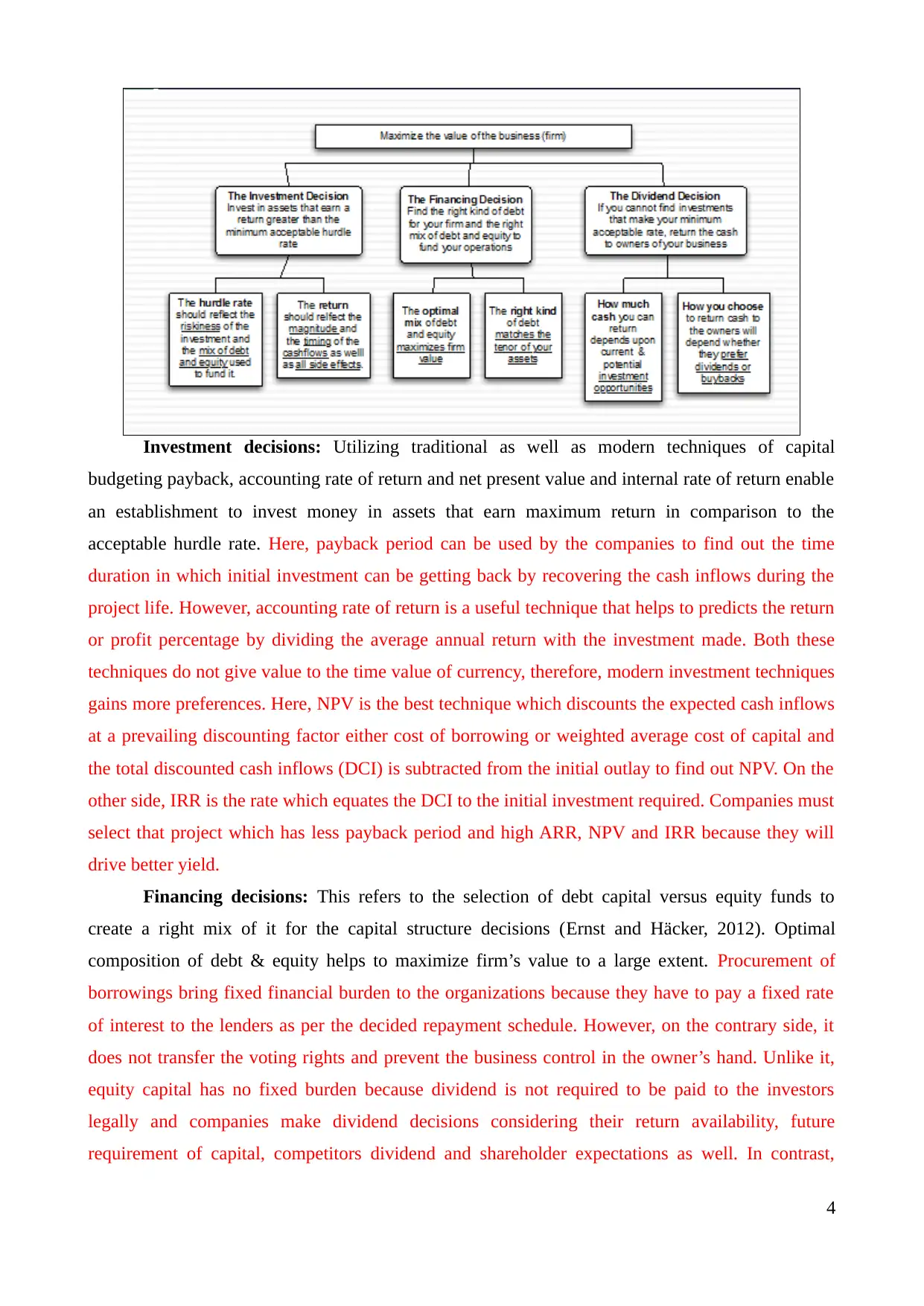
Investment decisions: Utilizing traditional as well as modern techniques of capital
budgeting payback, accounting rate of return and net present value and internal rate of return enable
an establishment to invest money in assets that earn maximum return in comparison to the
acceptable hurdle rate. Here, payback period can be used by the companies to find out the time
duration in which initial investment can be getting back by recovering the cash inflows during the
project life. However, accounting rate of return is a useful technique that helps to predicts the return
or profit percentage by dividing the average annual return with the investment made. Both these
techniques do not give value to the time value of currency, therefore, modern investment techniques
gains more preferences. Here, NPV is the best technique which discounts the expected cash inflows
at a prevailing discounting factor either cost of borrowing or weighted average cost of capital and
the total discounted cash inflows (DCI) is subtracted from the initial outlay to find out NPV. On the
other side, IRR is the rate which equates the DCI to the initial investment required. Companies must
select that project which has less payback period and high ARR, NPV and IRR because they will
drive better yield.
Financing decisions: This refers to the selection of debt capital versus equity funds to
create a right mix of it for the capital structure decisions (Ernst and Häcker, 2012). Optimal
composition of debt & equity helps to maximize firm’s value to a large extent. Procurement of
borrowings bring fixed financial burden to the organizations because they have to pay a fixed rate
of interest to the lenders as per the decided repayment schedule. However, on the contrary side, it
does not transfer the voting rights and prevent the business control in the owner’s hand. Unlike it,
equity capital has no fixed burden because dividend is not required to be paid to the investors
legally and companies make dividend decisions considering their return availability, future
requirement of capital, competitors dividend and shareholder expectations as well. In contrast,
4
budgeting payback, accounting rate of return and net present value and internal rate of return enable
an establishment to invest money in assets that earn maximum return in comparison to the
acceptable hurdle rate. Here, payback period can be used by the companies to find out the time
duration in which initial investment can be getting back by recovering the cash inflows during the
project life. However, accounting rate of return is a useful technique that helps to predicts the return
or profit percentage by dividing the average annual return with the investment made. Both these
techniques do not give value to the time value of currency, therefore, modern investment techniques
gains more preferences. Here, NPV is the best technique which discounts the expected cash inflows
at a prevailing discounting factor either cost of borrowing or weighted average cost of capital and
the total discounted cash inflows (DCI) is subtracted from the initial outlay to find out NPV. On the
other side, IRR is the rate which equates the DCI to the initial investment required. Companies must
select that project which has less payback period and high ARR, NPV and IRR because they will
drive better yield.
Financing decisions: This refers to the selection of debt capital versus equity funds to
create a right mix of it for the capital structure decisions (Ernst and Häcker, 2012). Optimal
composition of debt & equity helps to maximize firm’s value to a large extent. Procurement of
borrowings bring fixed financial burden to the organizations because they have to pay a fixed rate
of interest to the lenders as per the decided repayment schedule. However, on the contrary side, it
does not transfer the voting rights and prevent the business control in the owner’s hand. Unlike it,
equity capital has no fixed burden because dividend is not required to be paid to the investors
legally and companies make dividend decisions considering their return availability, future
requirement of capital, competitors dividend and shareholder expectations as well. In contrast,
4
Paraphrase This Document
Need a fresh take? Get an instant paraphrase of this document with our AI Paraphraser
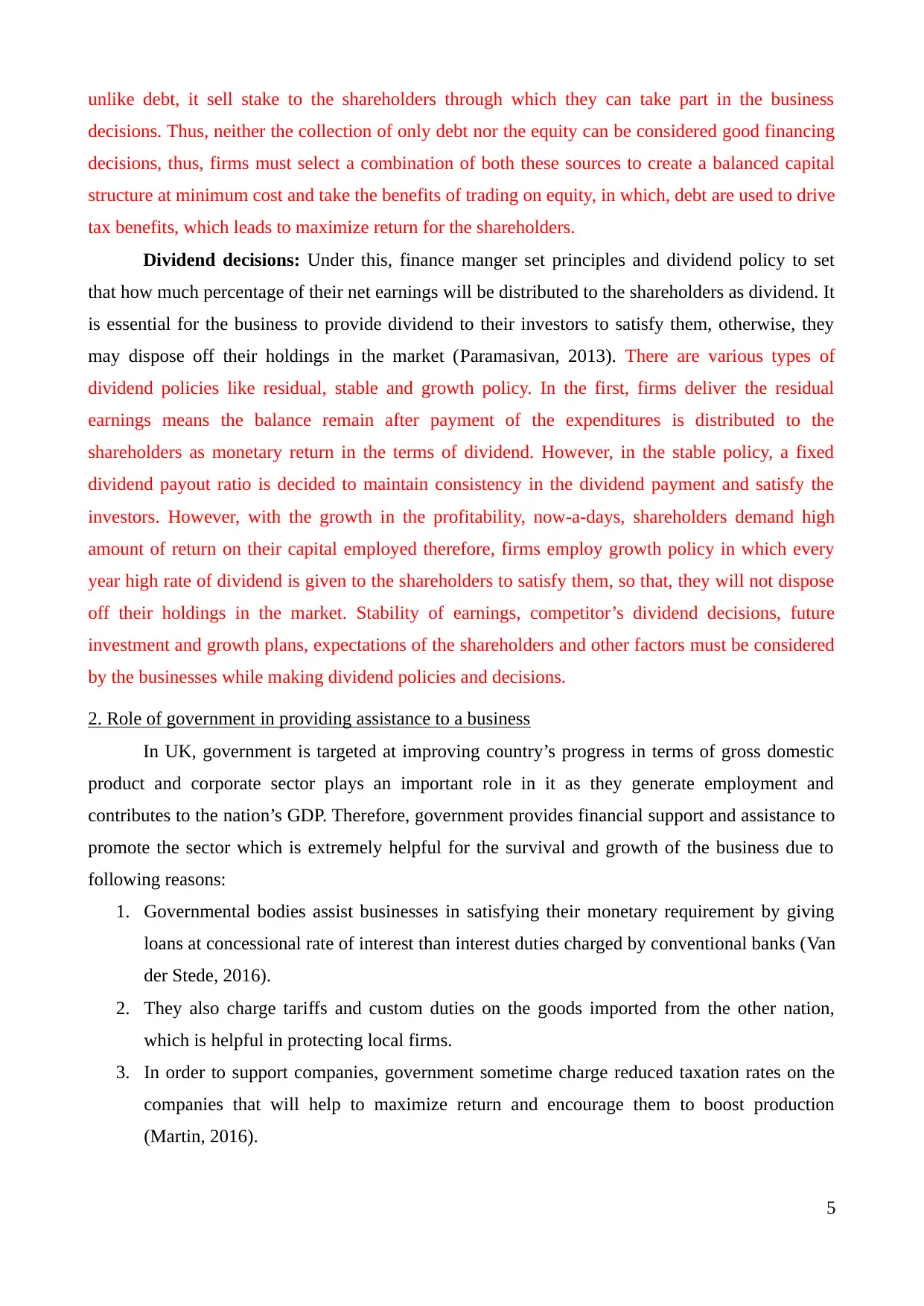
unlike debt, it sell stake to the shareholders through which they can take part in the business
decisions. Thus, neither the collection of only debt nor the equity can be considered good financing
decisions, thus, firms must select a combination of both these sources to create a balanced capital
structure at minimum cost and take the benefits of trading on equity, in which, debt are used to drive
tax benefits, which leads to maximize return for the shareholders.
Dividend decisions: Under this, finance manger set principles and dividend policy to set
that how much percentage of their net earnings will be distributed to the shareholders as dividend. It
is essential for the business to provide dividend to their investors to satisfy them, otherwise, they
may dispose off their holdings in the market (Paramasivan, 2013). There are various types of
dividend policies like residual, stable and growth policy. In the first, firms deliver the residual
earnings means the balance remain after payment of the expenditures is distributed to the
shareholders as monetary return in the terms of dividend. However, in the stable policy, a fixed
dividend payout ratio is decided to maintain consistency in the dividend payment and satisfy the
investors. However, with the growth in the profitability, now-a-days, shareholders demand high
amount of return on their capital employed therefore, firms employ growth policy in which every
year high rate of dividend is given to the shareholders to satisfy them, so that, they will not dispose
off their holdings in the market. Stability of earnings, competitor’s dividend decisions, future
investment and growth plans, expectations of the shareholders and other factors must be considered
by the businesses while making dividend policies and decisions.
2. Role of government in providing assistance to a business
In UK, government is targeted at improving country’s progress in terms of gross domestic
product and corporate sector plays an important role in it as they generate employment and
contributes to the nation’s GDP. Therefore, government provides financial support and assistance to
promote the sector which is extremely helpful for the survival and growth of the business due to
following reasons:
1. Governmental bodies assist businesses in satisfying their monetary requirement by giving
loans at concessional rate of interest than interest duties charged by conventional banks (Van
der Stede, 2016).
2. They also charge tariffs and custom duties on the goods imported from the other nation,
which is helpful in protecting local firms.
3. In order to support companies, government sometime charge reduced taxation rates on the
companies that will help to maximize return and encourage them to boost production
(Martin, 2016).
5
decisions. Thus, neither the collection of only debt nor the equity can be considered good financing
decisions, thus, firms must select a combination of both these sources to create a balanced capital
structure at minimum cost and take the benefits of trading on equity, in which, debt are used to drive
tax benefits, which leads to maximize return for the shareholders.
Dividend decisions: Under this, finance manger set principles and dividend policy to set
that how much percentage of their net earnings will be distributed to the shareholders as dividend. It
is essential for the business to provide dividend to their investors to satisfy them, otherwise, they
may dispose off their holdings in the market (Paramasivan, 2013). There are various types of
dividend policies like residual, stable and growth policy. In the first, firms deliver the residual
earnings means the balance remain after payment of the expenditures is distributed to the
shareholders as monetary return in the terms of dividend. However, in the stable policy, a fixed
dividend payout ratio is decided to maintain consistency in the dividend payment and satisfy the
investors. However, with the growth in the profitability, now-a-days, shareholders demand high
amount of return on their capital employed therefore, firms employ growth policy in which every
year high rate of dividend is given to the shareholders to satisfy them, so that, they will not dispose
off their holdings in the market. Stability of earnings, competitor’s dividend decisions, future
investment and growth plans, expectations of the shareholders and other factors must be considered
by the businesses while making dividend policies and decisions.
2. Role of government in providing assistance to a business
In UK, government is targeted at improving country’s progress in terms of gross domestic
product and corporate sector plays an important role in it as they generate employment and
contributes to the nation’s GDP. Therefore, government provides financial support and assistance to
promote the sector which is extremely helpful for the survival and growth of the business due to
following reasons:
1. Governmental bodies assist businesses in satisfying their monetary requirement by giving
loans at concessional rate of interest than interest duties charged by conventional banks (Van
der Stede, 2016).
2. They also charge tariffs and custom duties on the goods imported from the other nation,
which is helpful in protecting local firms.
3. In order to support companies, government sometime charge reduced taxation rates on the
companies that will help to maximize return and encourage them to boost production
(Martin, 2016).
5
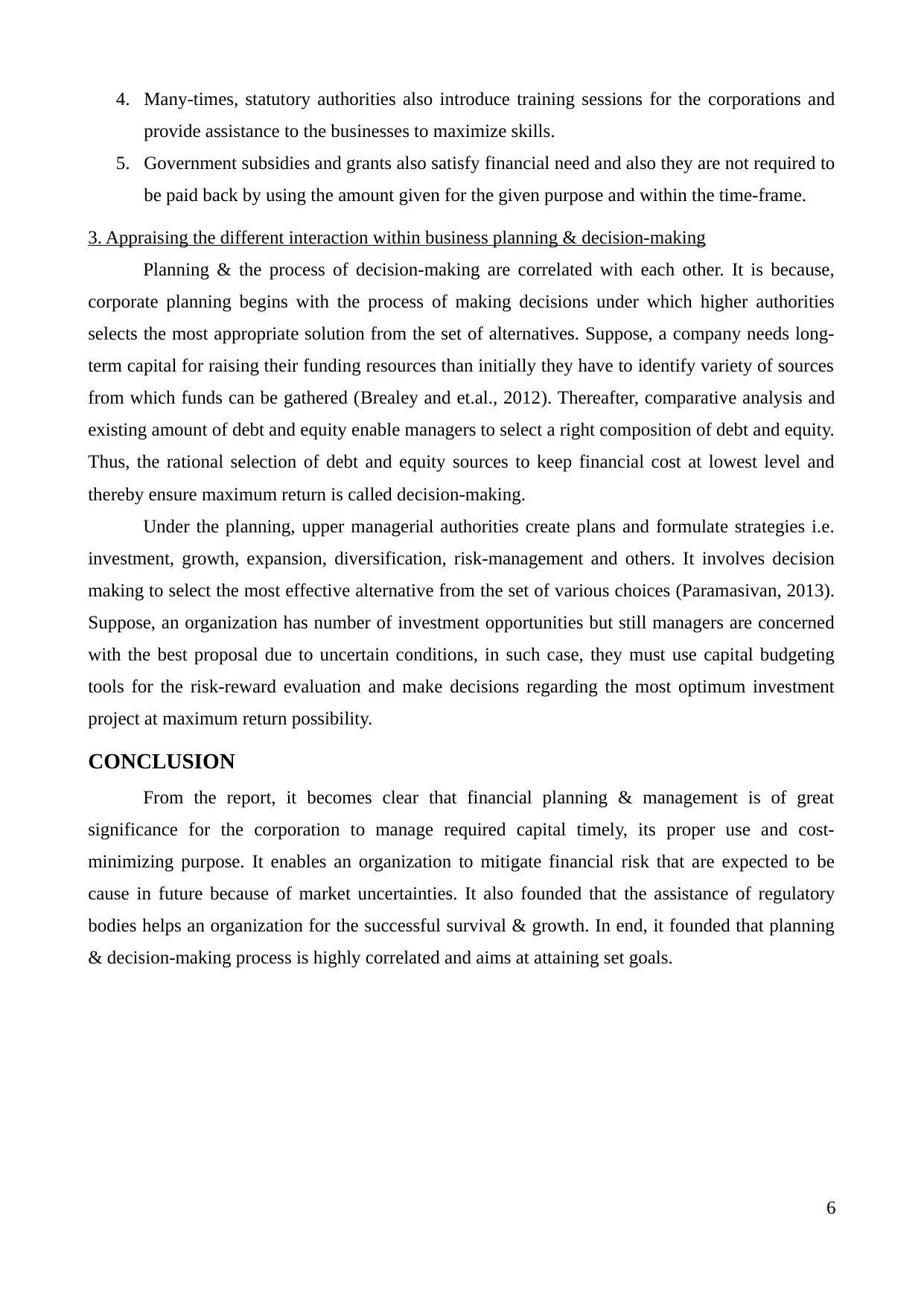
4. Many-times, statutory authorities also introduce training sessions for the corporations and
provide assistance to the businesses to maximize skills.
5. Government subsidies and grants also satisfy financial need and also they are not required to
be paid back by using the amount given for the given purpose and within the time-frame.
3. Appraising the different interaction within business planning & decision-making
Planning & the process of decision-making are correlated with each other. It is because,
corporate planning begins with the process of making decisions under which higher authorities
selects the most appropriate solution from the set of alternatives. Suppose, a company needs long-
term capital for raising their funding resources than initially they have to identify variety of sources
from which funds can be gathered (Brealey and et.al., 2012). Thereafter, comparative analysis and
existing amount of debt and equity enable managers to select a right composition of debt and equity.
Thus, the rational selection of debt and equity sources to keep financial cost at lowest level and
thereby ensure maximum return is called decision-making.
Under the planning, upper managerial authorities create plans and formulate strategies i.e.
investment, growth, expansion, diversification, risk-management and others. It involves decision
making to select the most effective alternative from the set of various choices (Paramasivan, 2013).
Suppose, an organization has number of investment opportunities but still managers are concerned
with the best proposal due to uncertain conditions, in such case, they must use capital budgeting
tools for the risk-reward evaluation and make decisions regarding the most optimum investment
project at maximum return possibility.
CONCLUSION
From the report, it becomes clear that financial planning & management is of great
significance for the corporation to manage required capital timely, its proper use and cost-
minimizing purpose. It enables an organization to mitigate financial risk that are expected to be
cause in future because of market uncertainties. It also founded that the assistance of regulatory
bodies helps an organization for the successful survival & growth. In end, it founded that planning
& decision-making process is highly correlated and aims at attaining set goals.
6
provide assistance to the businesses to maximize skills.
5. Government subsidies and grants also satisfy financial need and also they are not required to
be paid back by using the amount given for the given purpose and within the time-frame.
3. Appraising the different interaction within business planning & decision-making
Planning & the process of decision-making are correlated with each other. It is because,
corporate planning begins with the process of making decisions under which higher authorities
selects the most appropriate solution from the set of alternatives. Suppose, a company needs long-
term capital for raising their funding resources than initially they have to identify variety of sources
from which funds can be gathered (Brealey and et.al., 2012). Thereafter, comparative analysis and
existing amount of debt and equity enable managers to select a right composition of debt and equity.
Thus, the rational selection of debt and equity sources to keep financial cost at lowest level and
thereby ensure maximum return is called decision-making.
Under the planning, upper managerial authorities create plans and formulate strategies i.e.
investment, growth, expansion, diversification, risk-management and others. It involves decision
making to select the most effective alternative from the set of various choices (Paramasivan, 2013).
Suppose, an organization has number of investment opportunities but still managers are concerned
with the best proposal due to uncertain conditions, in such case, they must use capital budgeting
tools for the risk-reward evaluation and make decisions regarding the most optimum investment
project at maximum return possibility.
CONCLUSION
From the report, it becomes clear that financial planning & management is of great
significance for the corporation to manage required capital timely, its proper use and cost-
minimizing purpose. It enables an organization to mitigate financial risk that are expected to be
cause in future because of market uncertainties. It also founded that the assistance of regulatory
bodies helps an organization for the successful survival & growth. In end, it founded that planning
& decision-making process is highly correlated and aims at attaining set goals.
6
⊘ This is a preview!⊘
Do you want full access?
Subscribe today to unlock all pages.

Trusted by 1+ million students worldwide
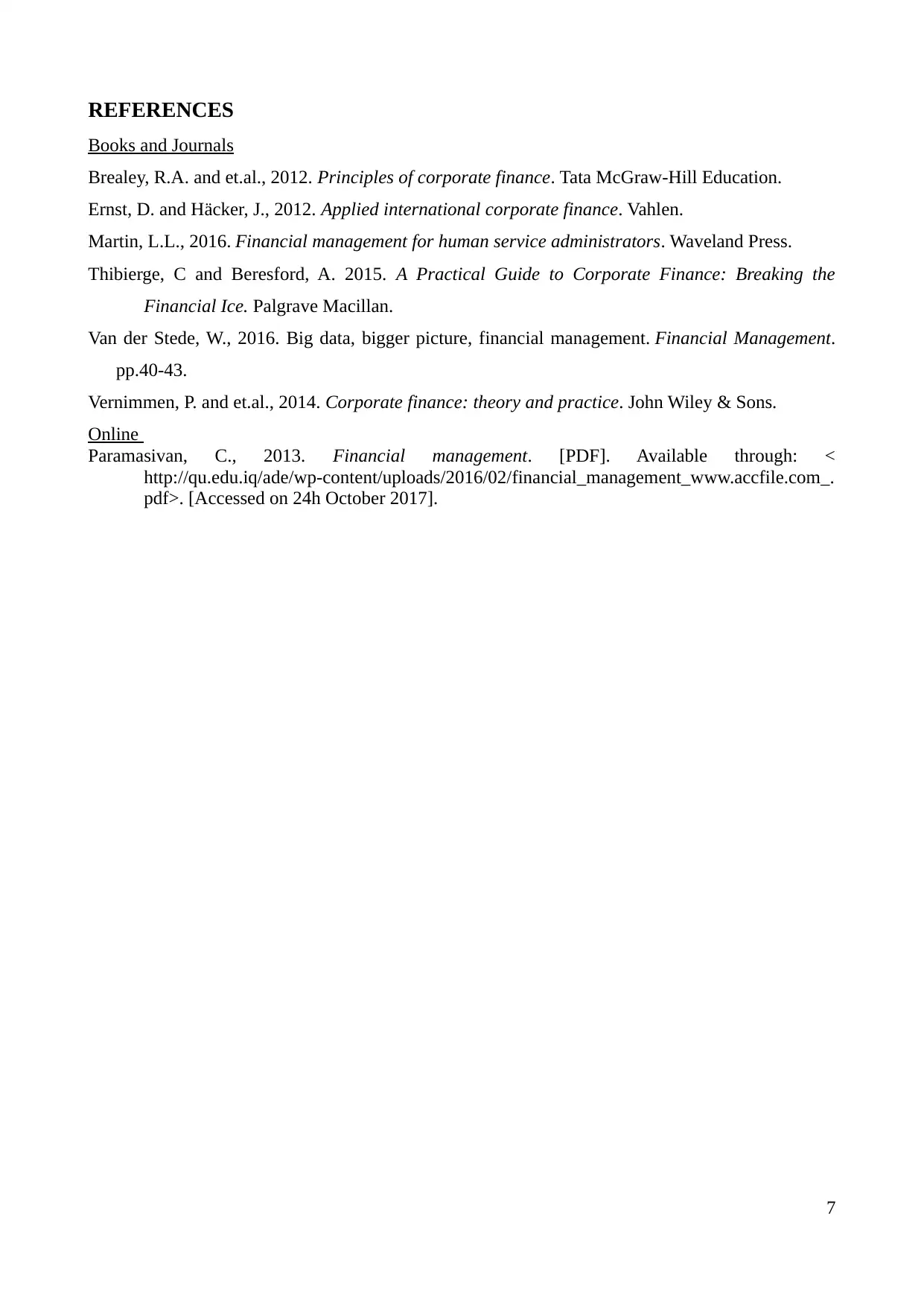
REFERENCES
Books and Journals
Brealey, R.A. and et.al., 2012. Principles of corporate finance. Tata McGraw-Hill Education.
Ernst, D. and Häcker, J., 2012. Applied international corporate finance. Vahlen.
Martin, L.L., 2016. Financial management for human service administrators. Waveland Press.
Thibierge, C and Beresford, A. 2015. A Practical Guide to Corporate Finance: Breaking the
Financial Ice. Palgrave Macillan.
Van der Stede, W., 2016. Big data, bigger picture, financial management. Financial Management.
pp.40-43.
Vernimmen, P. and et.al., 2014. Corporate finance: theory and practice. John Wiley & Sons.
Online
Paramasivan, C., 2013. Financial management. [PDF]. Available through: <
http://qu.edu.iq/ade/wp-content/uploads/2016/02/financial_management_www.accfile.com_.
pdf>. [Accessed on 24h October 2017].
7
Books and Journals
Brealey, R.A. and et.al., 2012. Principles of corporate finance. Tata McGraw-Hill Education.
Ernst, D. and Häcker, J., 2012. Applied international corporate finance. Vahlen.
Martin, L.L., 2016. Financial management for human service administrators. Waveland Press.
Thibierge, C and Beresford, A. 2015. A Practical Guide to Corporate Finance: Breaking the
Financial Ice. Palgrave Macillan.
Van der Stede, W., 2016. Big data, bigger picture, financial management. Financial Management.
pp.40-43.
Vernimmen, P. and et.al., 2014. Corporate finance: theory and practice. John Wiley & Sons.
Online
Paramasivan, C., 2013. Financial management. [PDF]. Available through: <
http://qu.edu.iq/ade/wp-content/uploads/2016/02/financial_management_www.accfile.com_.
pdf>. [Accessed on 24h October 2017].
7
1 out of 7
Related Documents
Your All-in-One AI-Powered Toolkit for Academic Success.
+13062052269
info@desklib.com
Available 24*7 on WhatsApp / Email
![[object Object]](/_next/static/media/star-bottom.7253800d.svg)
Unlock your academic potential
Copyright © 2020–2025 A2Z Services. All Rights Reserved. Developed and managed by ZUCOL.




